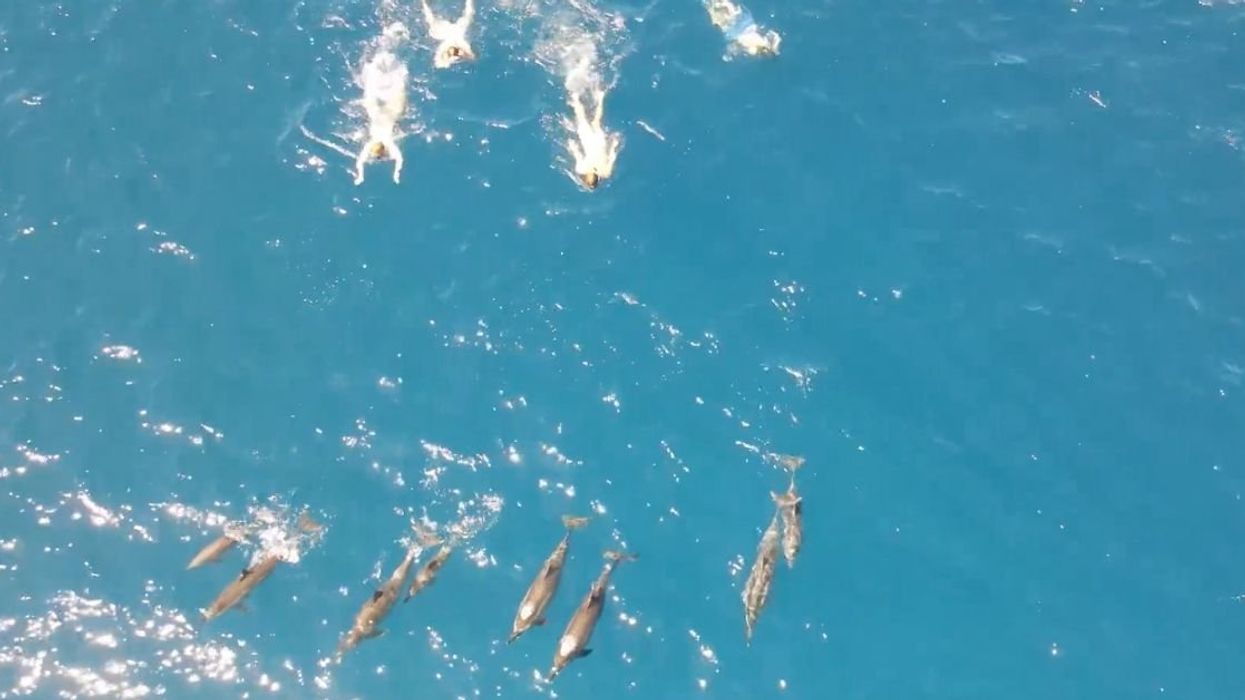Social media users were outraged after drone footage revealed a group of swimmers appearing to be pursuing and harassing a pod of dolphins in Hōnaunau Bay, Hawaii.
The swimmers were spotted during a patrol violation on Sunday morning.
According to Hawaii.gov, the DLNR Division of Conservation and Resources Enforcement (DOCARE) officers have alerted the 33 swimmers to the violation.
Federal officers instituted a law in 2021 prohibiting swimmers from coming within 50 yards of spinner dolphins near the Big Island–specifically along the shores of Lanai, Maui, and Kahoolawe.
It was meant to protect the aquatic mammals from tourists who often try to swim with them–which can lead to a disruption in the nocturnal animals' sleep cycle.
Spinner dolphins sleep in shallow bays during the day to conserve enough energy to hunt for food at night.
Their diet typically consist of fish and small crustaceans that appear near the surface of the water after dark.
Unfortunately, where they sleep in daylight is susceptible to curious tourists who want to swim near and around them, and therefore, depriving the animals of rest.
Here is the drone footage of the swimmers aggressively approaching the dolphins.
DOCARE and the NOAA Office of Law Enforcement (OLE) launched a joint investigation after the swimmers were met ashore by uniformed officers.

\u201c@yashar Lemme guess, they were not native Hawaiian\u201d— Yashar Ali \ud83d\udc18 \u06cc\u0627\u0634\u0627\u0631 (@Yashar Ali \ud83d\udc18 \u06cc\u0627\u0634\u0627\u0631) 1680122713

\u201cMore than 30 swimmers are under investigation after they were seen "aggressively" harassing a pod of wild dolphins near Hawaii's Big Island, authorities say. https://t.co/agpRtYQqW7\u201d— CBS News (@CBS News) 1680121800
Social media users condemned the swimmers for disturbing the creatures of the sea en masse.
\u201c@CBSNews Shame on them!\u201d— CBS News (@CBS News) 1680121800
\u201c@CBSNews Idiots \ud83d\ude2b \ud83d\udc2c\ud83d\udc2c \ud83c\udf0a\u201d— CBS News (@CBS News) 1680121800
\u201c@CBSNews Put them in jail \ud83d\ude4f\ud83c\udffb\ud83d\ude4f\ud83c\udffb\ud83d\ude4f\ud83c\udffb\ud83d\ude4f\ud83c\udffb\ud83d\ude4f\ud83c\udffb\ud83d\ude4f\ud83c\udffb\ud83d\ude4f\ud83c\udffb\ud83c\udde8\ud83c\udde6\u201d— CBS News (@CBS News) 1680121800
\u201c@CBSNews Shameful behavior, bullies\u201d— CBS News (@CBS News) 1680121800
\u201c@NBCNews Some humans really suck.\u201d— NBC News (@NBC News) 1680189610
\u201c@NBCNews I hate people\u201d— NBC News (@NBC News) 1680189610
\u201c@ABC How sickening, what\u2019s wrong with people?!\u201d— ABC News (@ABC News) 1680189153
\u201c@BBCWorld We don\u2019t deserve nice things.\u201d— BBC News (World) (@BBC News (World)) 1680098410
\u201c@yashar I wish everyone treated every place they went to with respect tbh. Poor dolphins. Just trying to exist. And being harassed for it. \ud83d\ude2d\ud83d\ude30\u201d— Yashar Ali \ud83d\udc18 \u06cc\u0627\u0634\u0627\u0631 (@Yashar Ali \ud83d\udc18 \u06cc\u0627\u0634\u0627\u0631) 1680122713
\u201c@yashar For the love of... don't harass wild animals.\n\nIf you have gopher or whatever is ruining your lawn then trap and dispatch it, but don't harass animals.\u201d— Yashar Ali \ud83d\udc18 \u06cc\u0627\u0634\u0627\u0631 (@Yashar Ali \ud83d\udc18 \u06cc\u0627\u0634\u0627\u0631) 1680122713
How to teach these swimmers a lesson?
Twitter had some thoughts.
\u201c@CBSNews Too bad there wasn't a couple of hungry great white sharks around...\n\nHumans are just repellent sometimes.....\u201d— CBS News (@CBS News) 1680121800
\u201c@CBSNews Its payback time\nhttps://t.co/6bHI6WsZ06\u201d— CBS News (@CBS News) 1680121800
\u201c@yashar Please tell me there is no law against a dolphin biting down on a swmmier\u2019s ankle and pulling them to the bottom of the sea?\u201d— Yashar Ali \ud83d\udc18 \u06cc\u0627\u0634\u0627\u0631 (@Yashar Ali \ud83d\udc18 \u06cc\u0627\u0634\u0627\u0631) 1680122713
\u201c@yashar See, this is why I couldn\u2019t be in law enforcement because I\u2019d arrest them, drive them out to sea and dump them overboard at the sign of the first shark. Fired on day 1!\u201d— Yashar Ali \ud83d\udc18 \u06cc\u0627\u0634\u0627\u0631 (@Yashar Ali \ud83d\udc18 \u06cc\u0627\u0634\u0627\u0631) 1680122713
Yahoo! News noted how even in sleep, dolphins still need to be moving and surfacing for air.
As humans, this contradiction of our own sleeping behavior often misleads tourists into thinking the animals are active when they are actively resting.














 J. Crew
J. Crew
 @bravowwhl/TikTok
@bravowwhl/TikTok @bravowwhl/TikTok
@bravowwhl/TikTok @bravowwhl/TikTok
@bravowwhl/TikTok @bravowwhl/TikTok
@bravowwhl/TikTok @bravowwhl/TikTok
@bravowwhl/TikTok @bravowwhl/TikTok
@bravowwhl/TikTok

 wildlife mt GIF
wildlife mt GIF  Disney Perfect Loops GIF
Disney Perfect Loops GIF  Tired Music Video GIF by Elvie Shane
Tired Music Video GIF by Elvie Shane  Art Magic GIF by rubedox
Art Magic GIF by rubedox